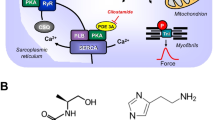Abstract.
We have shown previously that histaprodifen and its N α-substituted analogues methylhistaprodifen and dimethylhistaprodifen are highly potent H1-receptor agonists in vivo. The aim of the present study was to examine the influence of four newly synthesized histaprodifen analogues, 3-fluoro-methylhistaprodifen (1), N α-imidazolylethylhistaprodifen (2), bis-histaprodifen (3) and N α-methyl-bis-histaprodifen (4), on the cardiovascular system in the pithed and in the anaesthetized rat.
In pithed and vagotomized rats, diastolic blood pressure (which was increased to 80–85 mmHg by vasopressin infusion) was decreased dose dependently by methylhistaprodifen (the reference compound) and by compounds 1–4. The maximum decrease was about 47–50 mmHg for methylhistaprodifen and compounds 1, 2 and 3. Their potencies, expressed as pED50 (the negative logarithm of the dose in mole per kilogram body weight that decreased diastolic blood pressure by 25 mmHg), were 8.31, 8.23, 8.26 and 7.84, respectively. With compound 4 the maximal effect was not achieved at doses up to 1 µmol/kg (the latter dose decreased blood pressure by about 30 mmHg; pED50≈6.5). The vasodepressor effect of the five compounds was attenuated by the H1-receptor antagonist dimetindene (1 µmol/kg) but was not changed by combined administration of the H2- and H3-receptor antagonists ranitidine and thioperamide (1 µmol/kg each), by combined administration of the α1- and α2-adrenoceptor antagonists prazosin and rauwolscine (1 µmol/kg each) or by the β-adrenoceptor antagonist propranolol (3 µmol/kg). In anaesthetized rats methylhistaprodifen and compounds 1–4 induced almost the same fall in blood pressure as in pithed and vagotomized animals; the effects were sensitive to blockade by dimetindene (1 µmol/kg). Higher doses of compounds 1 and 2 (1 µmol/kg) increased heart rate in pithed and vagotomized rats in a manner sensitive to propranolol (3 µmol/kg) but insensitive to dimetindene (3 µmol/kg). The same dose of methylhistaprodifen and of compounds 3 and 4 failed to affect heart rate.
We conclude that the agonistic potency of compounds 1 and 2 at H1-receptors in the cardiovascular system of the rat equals that of methylhistaprodifen, the most potent histamine H1-receptor agonist available until recently. Compounds 1 and 2 exhibit sympathomimetic activity at high doses.
Similar content being viewed by others
Author information
Authors and Affiliations
Additional information
Electronic Publication
Rights and permissions
About this article
Cite this article
Schlicker, .E., Kozłowska, .H., Kwolek, .G. et al. Novel histaprodifen analogues as potent histamine H1-receptor agonists in the pithed and in the anaesthetized rat. Naunyn-Schmied Arch Pharmacol 364, 14–20 (2001). https://doi.org/10.1007/s002100100414
Received:
Accepted:
Issue Date:
DOI: https://doi.org/10.1007/s002100100414




